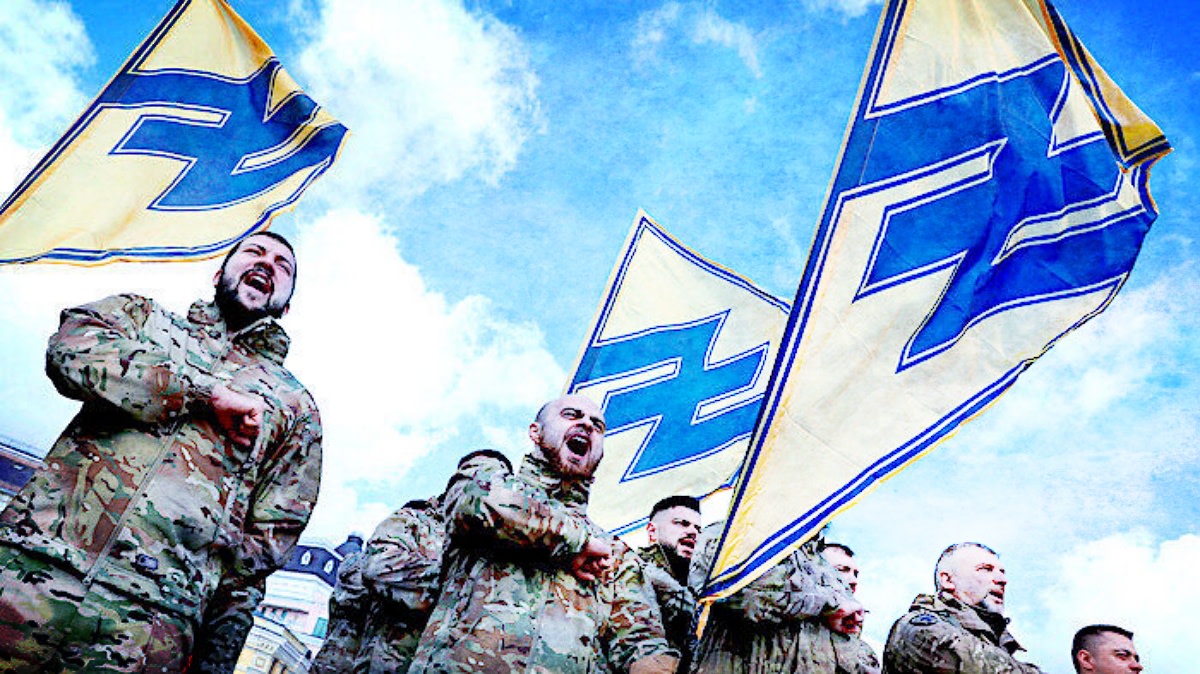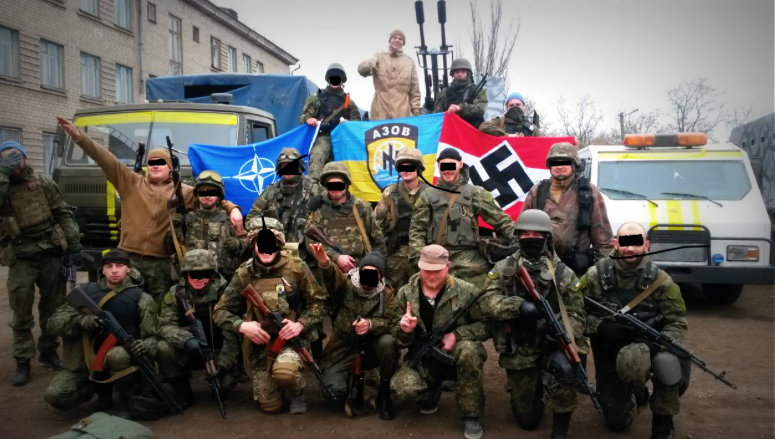
Russia is using the presence of neo-Nazis
in Ukraine as a pretext for war, but
the West is sweeping it under the rug
Medea Benjamin and Nicolas J. S. Davis / The Fair Observer
(March 11, 2022) — President Vladimir Putin has claimed that he ordered the Russian invasion of Ukraine to “denazify” its government. Western officials, such as former US Ambassador to Russia Michael McFaul, have called this pure propaganda, insisting, “There are no Nazis in Ukraine.”
In the context of the Russian invasion, the post-2014 Ukrainian government’s problematic relationship with extreme right-wing parties and neo-Nazi groups has become an incendiary element on both sides of the propaganda war, with Russia exaggerating it as a pretext for war and the West trying to sweep it under the rug.
The reality behind the propaganda is that the West and its Ukrainian allies have opportunistically exploited and empowered the extreme right in Ukraine, first to pull off a coup amidst anti-government protests in 2014 and then by redirecting it to fight separatists in eastern Ukraine.
And far from “denazifying” Ukraine, the Russian invasion is likely to further empower Ukrainian and international neo-Nazis, as the conflict attracts fighters from around the world and provides them with weapons, military training and the combat experience that many of them are hungry for.

The Extreme Right in Ukraine
Ukraine’s extreme right-wing Svoboda party and its founders, Oleh Tyahnybok and Andriy Parubiy, played leading roles in the US-backed coup in February 2014. During an infamously leaked phone conversation before the Ukrainian government’s ouster, US Assistant Secretary of State Victoria Nuland and Ambassador Geoffrey Pyatt mentioned Tyahnybok as one of the leaders they were working with, even as they tried to exclude him from an official position in the new government.
At that time, previously peaceful protests in Kyiv, the Ukrainian capital, gave way to pitched battles with police and armed marches to try to break through barricades and reach parliament. Members of Svoboda and the newly-formed Right Sector militia, led by Dmytro Yarosh, battled officers, spearheaded marches and raided a police armory for weapons. By mid-February 2014, these men with guns were the de facto leaders of the Maidan protests.
We will never know what kind of political transition peaceful protests alone would have led to in Ukraine or how different the new government would have been if a peaceful process had been allowed to take its course, without interference by the US or violent right-wing extremists.
But it was Yarosh who took to the stage in the Maidan and rejected the February 21 agreement negotiated by European foreign ministers, under which then-President Viktor Yanukovych and opposition political leaders agreed to hold new elections later that year. Instead, Yarosh and the Right Sector refused to disarm and led the climactic march on parliament that overthrew the government.
Ukrainian Leaders
Since 1991, Ukrainian elections had swung back and forth between leaders like Yanukovych, who is from Donetsk and had close ties with Russia, and Western-backed leaders like Viktor Yushchenko, who was elected in 2005 after the Orange Revolution that followed a disputed election. Ukraine’s endemic corruption tainted every government, and public disillusionment with whichever leader and party won power led to a see-saw between Western and Russian-aligned factions.
In 2014, Nuland and the US State Department got their favorite, Arseniy Yatsenyuk, installed as prime minister of the new government. He lasted two years, until he, too, lost his job due to endless corruption scandals. Petro Poroshenko, the new president, lasted a bit longer, until 2019, even after his personal tax evasion schemes were exposed in the 2016 Panama Papers and 2017 Paradise Papers.
When Yatsenyuk became prime minister, he rewarded Svoboda’s role in the coup with three cabinet positions, including Oleksander Sych as deputy prime minister, and governorships of three of Ukraine’s 25 provinces. Andriy Parubiy — who founded the fascist Social National Party that went on to become Svoboda — was appointed chairman of parliament, a post he held for the next five years. Tyahnybok ran for president in 2014, but he only got 1.2% of the votes and was not reelected to parliament.
Ukrainian voters turned their backs on the extreme right in the 2014 elections, reducing Svoboda’s 10.4% share of the national vote in 2012 to 4.7%. Svoboda lost support in areas where it held control of local governments but had failed to live up to its promises, and its support was split now that it was no longer the only party running on explicitly anti-Russian slogans and rhetoric.

Azov Battalion
After Yanukovich was toppled, the Right Sector helped to consolidate the new order by attacking and breaking up anti-coup protests, in what Yarosh described to Newsweek as a war to “cleanse the country” of pro-Russian protesters. This campaign climaxed on May 2, 2014, with the massacre of 42 protesters in a fiery inferno, after they took shelter from Right Sector attackers in the Trades Unions House in Odessa.
After protests evolved into declarations of independence in the Donetsk and Luhansk regions of Donbas in the east, the extreme right in Ukraine shifted gear to full-scale armed combat. The Ukrainian military had little enthusiasm for fighting its own people, so the government formed new National Guard units to do so.
The Right Sector formed a unit, and neo-Nazis also dominated the Azov Battalion, which was founded by Andriy Biletsky, an avowed white supremacist who claimed that Ukraine’s national purpose was to rid the country of Jews and other inferior races. It was the Azov Battalion, which was incorporated into the National Guard in 2014, that led the new government’s assault on the self-declared republics in eastern Ukraine and retook the city of Mariupol from separatist forces.
The Minsk II agreement in 2015 ended the worst fighting and set up a buffer zone around the breakaway republics of Donbas, but a low-intensity civil war continued. An estimated 14,000 people have been killed since 2014.
US Representative Ro Khanna and progressive members of Congress tried for several years to end military aid to the Azov Battalion.
In September 2017, the House amended the Defense Appropriations Act to ban military aid to the militia, but it is not clear how effective it ban has been. Since the Azov Battalion is fully integrated into the Ukrainian armed forces, it would take targeted efforts by US forces in Ukraine to ensure it does not receive the same weapons and support as other units. Today, in the midst of a war and a huge influx of US military aid, that would seem to be almost impossible.
In 2019, the Soufan Center, which tracks terrorist and extremist groups around the world, warned, “The Azov Battalion is emerging as a critical node in the transnational right-wing violent extremist network… [Its] aggressive approach to networking serves one of the Azov Battalion’s overarching objectives, to transform areas under its control in Ukraine into the primary hub for transnational white supremacy.”
The center described how the Azov Battalion’s “aggressive networking” reaches around the world to recruit fighters and spread its white supremacist ideology. Foreign fighters who train and fight with the Azov Battalion then return to their own countries to apply what they have learned and recruit others.
Violent foreign extremists with links to Azov include Brenton Tarrant, who massacred 51 worshippers at a mosque in Christchurch in New Zealand in 2019, and several members of the US Rise Above Movement who were prosecuted for attacking counter-protesters at the Unite the Right rally in Charlottesville in 2017. Other Azov veterans have returned to Australia, Brazil, Germany, Italy, Norway, Sweden, the UK and other countries, according to the Soufan Center.
Despite Svoboda’s declining success in national elections, neo-Nazi and extreme nationalist groups linked to the Azov Battalion have maintained power on the street in Ukraine and in local politics in the nationalist heartland around Lviv, a city in the west of the country.
After President Volodymyr Zelensky’s election in 2019, the extreme right allegedly threatened him with removal from office, or even death, if he negotiated with separatist leaders from Donbas and followed through on the Minsk Protocol. Zelensky ran for election as a peace candidate, but under threat from the right, he refused to even talk to Donbas representatives, whom he dismissed as terrorists.
During Donald Trump’s presidency, the United States reversed Barack Obama’s ban on weapons sales to Ukraine. Zelensky’s aggressive rhetoric raised new fears in Donbas and Russia that he was building up Ukraine’s forces for a new offensive to retake Donetsk and Luhansk from separatists.

Neoliberalism in Ukraine
The civil war in eastern Ukraine, combined with the government’s neoliberal economic policies, created fertile ground for the extreme right. The new government imposed more of the same neoliberal “shock therapy” that was imposed throughout Eastern Europe in the 1990s. In 2015, Ukraine received a $40-billion IMF bailout. Part of the deal, Tony Wood explains in an article for the N+1 website, would include privatizing state-owned enterprises, reducing public sector employment by 20%, cutting health-care benefits and cutting investment in public education.
Coupled with Ukraine’s endemic corruption, these policies led to the profitable looting of state assets by the corrupt ruling class and to falling living standards and austerity measures for everybody else. The post-2014 government upheld Poland as its model, but the reality was closer to Boris Yeltsin’s Russia in the 1990s. Ukraine’s GDP plummeted between 2012 and 2016, making it the poorest country in Europe.
As elsewhere, the failures of neoliberalism have fueled the rise of right-wing extremism and racism. Now, the war with Russia promises to provide thousands of alienated young men from around the world with military training and combat experience, which they can then take home to terrorize their own countries.
The Soufan Center has compared the Azov Battalion’s international networking strategy to that of al-Qaeda and the Islamic State group. US and NATO support for the Azov Battalion poses similar risks as their support for al-Qaeda-linked groups in Syria 10 years ago. Those chickens quickly came home to roost, of course.
Right now, Ukrainians are united in their resistance to Russia’s invasion. But we should not be surprised when the Western alliance with extreme right-wing proxy forces in Ukraine, including the infusion of billions of dollars in sophisticated weapons, results in similarly violent and destructive blowback.
Related News
Is Bosnia-Herzegovina Next on Russia’s Radar?
The views expressed in this article are the author’s own and do not necessarily reflect Fair Observer’s editorial policy.
For more than 10 years, Fair Observer has been free, fair and independent. No billionaire owns us, no advertisers control us. We are a reader-supported nonprofit. Unlike many other publications, we keep our content free for readers regardless of where they live or whether they can afford to pay. We have no paywalls and no ads.
In the post-truth era of fake news, echo chambers and filter bubbles, we publish a plurality of perspectives from around the world. Anyone can publish with us, but everyone goes through a rigorous editorial process. So, you get fact-checked, well-reasoned content instead of noise.
We publish 2,500+ voices from 90+ countries. We also conduct education and training programs on subjects ranging from digital media and journalism to writing and critical thinking. This doesn’t come cheap. Servers, editors, trainers and web developers cost money.
Posted in accordance with Title 17, Section 107, US Code, for noncommercial, educational purposes.